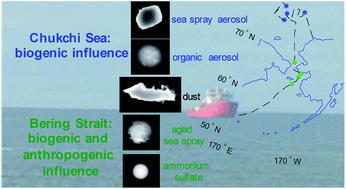当前位置:
X-MOL 学术
›
Environ. Sci.: Processes Impacts
›
论文详情
Our official English website, www.x-mol.net, welcomes your
feedback! (Note: you will need to create a separate account there.)
Emerging investigator series: influence of marine emissions and atmospheric processing on individual particle composition of summertime Arctic aerosol over the Bering Strait and Chukchi Sea.
Environmental Science: Processes & Impacts ( IF 4.3 ) Pub Date : 2020-02-11 , DOI: 10.1039/c9em00495e Rachel M Kirpes 1 , Blanca Rodriguez , Saewung Kim , Swarup China , Alexander Laskin , Keyhong Park , Jinyoung Jung , Andrew P Ault , Kerri A Pratt
Environmental Science: Processes & Impacts ( IF 4.3 ) Pub Date : 2020-02-11 , DOI: 10.1039/c9em00495e Rachel M Kirpes 1 , Blanca Rodriguez , Saewung Kim , Swarup China , Alexander Laskin , Keyhong Park , Jinyoung Jung , Andrew P Ault , Kerri A Pratt
Affiliation

|
The Arctic is rapidly transforming due to sea ice loss, increasing shipping activity, and oil and gas development. Associated marine and combustion emissions influence atmospheric aerosol composition, impacting complex aerosol-cloud-climate feedbacks. To improve understanding of the sources and processes determining Arctic aerosol composition, atmospheric particles were collected aboard the Korean icebreaker R/V Araon cruising within the Bering Strait and Chukchi Sea during August 2016. Offline analyses of individual particles by microspectroscopic techniques, including scanning electron microscopy with energy dispersive X-ray spectroscopy and atomic force microscopy with infrared spectroscopy, provided information on particle size, morphology, and chemical composition. The most commonly observed particle types were sea spray aerosol (SSA), comprising ∼60-90%, by number, of supermicron particles, and organic aerosol (OA), comprising ∼50-90%, by number, of submicron particles. Sulfate and nitrate were internally mixed within both SSA and OA particles, consistent with particle multiphase reactions during atmospheric transport. Within the Bering Strait, SSA and OA particles were more aged, with greater number fractions of particles containing sulfate and/or nitrate, compared to particles collected over the Chukchi Sea. This is indicative of greater pollution influence within the Bering Strait from coastal and inland sources, while the Chukchi Sea is primarily influenced by marine sources.
中文翻译:

新兴研究者系列:海洋排放和大气处理对白令海峡和楚科奇海夏季夏季北极气溶胶单个颗粒组成的影响。
由于海冰的流失,运输活动的增加以及油气的发展,北极正在迅速转变。相关的海洋和燃烧排放会影响大气中的气溶胶成分,从而影响复杂的气溶胶-云-气候反馈。为了更好地了解决定北极气溶胶成分的来源和过程,2016年8月在白令海峡和楚科奇海的韩国破冰船R / V Araon巡游中收集了大气颗粒。通过显微技术,包括扫描电子显微镜,对单个颗粒进行离线分析借助能量色散X射线光谱学和原子力显微镜与红外光谱学,可提供有关粒度,形态和化学成分的信息。最常见的颗粒类型是海雾气溶胶(SSA),包含约60-90%的超微粒子,有机气溶胶(OA)包含约50-90%的亚微粒子。硫酸盐和硝酸盐在SSA和OA颗粒内部内部混合,这与大气传输过程中的颗粒多相反应一致。在白令海峡内,与在楚科奇海采集的颗粒相比,SSA和OA颗粒的老化时间更长,含有硫酸盐和/或硝酸盐的颗粒数量更多。这表明白令海峡内沿海和内陆来源的污染影响更大,而楚科奇海主要受到海洋来源的影响。硫酸盐和硝酸盐在内部混合在SSA和OA颗粒中,这与大气传输过程中的颗粒多相反应一致。在白令海峡内,与在楚科奇海上收集的颗粒相比,SSA和OA颗粒的老化时间更长,含有硫酸盐和/或硝酸盐的颗粒数量更多。这表明白令海峡内沿海和内陆来源的污染影响更大,而楚科奇海主要受到海洋来源的影响。硫酸盐和硝酸盐在内部混合在SSA和OA颗粒中,这与大气传输过程中的颗粒多相反应一致。在白令海峡内,与在楚科奇海采集的颗粒相比,SSA和OA颗粒的老化时间更长,含有硫酸盐和/或硝酸盐的颗粒数量更多。这表明白令海峡内沿海和内陆来源的污染影响更大,而楚科奇海主要受到海洋来源的影响。
更新日期:2020-02-11
中文翻译:

新兴研究者系列:海洋排放和大气处理对白令海峡和楚科奇海夏季夏季北极气溶胶单个颗粒组成的影响。
由于海冰的流失,运输活动的增加以及油气的发展,北极正在迅速转变。相关的海洋和燃烧排放会影响大气中的气溶胶成分,从而影响复杂的气溶胶-云-气候反馈。为了更好地了解决定北极气溶胶成分的来源和过程,2016年8月在白令海峡和楚科奇海的韩国破冰船R / V Araon巡游中收集了大气颗粒。通过显微技术,包括扫描电子显微镜,对单个颗粒进行离线分析借助能量色散X射线光谱学和原子力显微镜与红外光谱学,可提供有关粒度,形态和化学成分的信息。最常见的颗粒类型是海雾气溶胶(SSA),包含约60-90%的超微粒子,有机气溶胶(OA)包含约50-90%的亚微粒子。硫酸盐和硝酸盐在SSA和OA颗粒内部内部混合,这与大气传输过程中的颗粒多相反应一致。在白令海峡内,与在楚科奇海采集的颗粒相比,SSA和OA颗粒的老化时间更长,含有硫酸盐和/或硝酸盐的颗粒数量更多。这表明白令海峡内沿海和内陆来源的污染影响更大,而楚科奇海主要受到海洋来源的影响。硫酸盐和硝酸盐在内部混合在SSA和OA颗粒中,这与大气传输过程中的颗粒多相反应一致。在白令海峡内,与在楚科奇海上收集的颗粒相比,SSA和OA颗粒的老化时间更长,含有硫酸盐和/或硝酸盐的颗粒数量更多。这表明白令海峡内沿海和内陆来源的污染影响更大,而楚科奇海主要受到海洋来源的影响。硫酸盐和硝酸盐在内部混合在SSA和OA颗粒中,这与大气传输过程中的颗粒多相反应一致。在白令海峡内,与在楚科奇海采集的颗粒相比,SSA和OA颗粒的老化时间更长,含有硫酸盐和/或硝酸盐的颗粒数量更多。这表明白令海峡内沿海和内陆来源的污染影响更大,而楚科奇海主要受到海洋来源的影响。











































 京公网安备 11010802027423号
京公网安备 11010802027423号